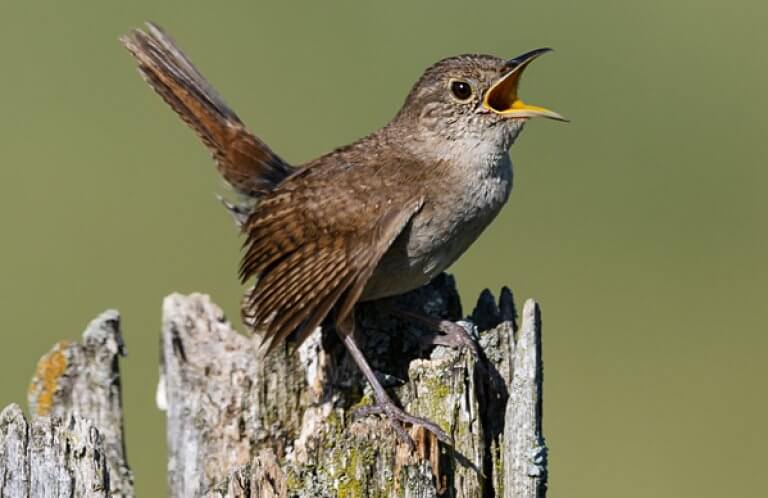About the Rock Wren
As its name suggests, the Rock Wren is a bird of rugged areas, particularly boulder-strewn slopes, canyons, and cliffs. This large, pale-colored wren is beautifully camouflaged to blend into its craggy habitat, with a black-speckled gray back and lighter underside, usually with buffy flanks. Other key ID features are its faint eye-stripe, long, slightly curved beak, and barred undertail coverts and tail.
The Rock Wren are usually seen in pairs, and the sexes look alike. It often bobs its entire body up and down while perched, looking for all the world as if it's doing deep knee bends — a behavioral quirk it shares with the American Dipper.
The Rock Wren is a near relative to another western wren species, the Canyon Wren, and the two share similar habitats, although the Rock Wren is larger and lighter-colored.
Although the Rock Wren nests out of sight within cracks and crevices, it's usually easy to locate a breeding pair.
A Stony Welcome Mat
Although a Rock Wren pair hides its nest within a craggy crevice, that location is easily detected by the telltale pathway of small rocks, sticks, and pebbles that they build leading up to the site. This stony trail, which may help provide drainage to the site, extends into the nest crevice itself. The adult birds may also stack small rocks at the crevice entrance to reduce the size of its opening, probably providing extra protection from predators and nest parasites.
Songs and Sounds
Like the Indigo Bunting and Song Sparrow, the male Rock Wren is a prolific singer and can accumulate a repertoire of 100 or more song types, many learned from neighboring wrens.
Listen to its song here:
Calls:
Breeding and Feeding
The Rock Wren forms monogamous pairs during the breeding season. A male establishes territory and attracts a mate by singing from atop a rock outcrop or another prominent perch, bobbing up and down all the while. The male will also feed his mate during courtship.
Both sexes work to build the cup-shaped nest, which is located within a ground-level crevice or other opening. First the pair creates a walkway to the site (see above), then builds a stony nest foundation, upon which the female builds a loose cup of grasses, wood, and bark, lined with softer materials such as animal hair and spiderweb silk. Nest sites may be reused over multiple years.

The female Rock Wren lays a clutch of 5-6 eggs, which she incubates alone, although her mate brings her food while she's on the nest. The eggs hatch after approximately two weeks; both parents feed the naked, helpless chicks, which grow quickly and fledge in another two weeks. The parents continue to feed their young for another week, and the fledglings remain in their parents' territory for another month. A pair of Rock Wrens may raise two to three broods per year. This wren is sometimes parasitized by the Brown-headed Cowbird.
Like the related House Wren, the Rock Wren feeds mainly on insects, larvae, spiders, and earthworms. It forages actively across the ground, probing rocky areas with its long, thin bill in search of prey. It will pluck insects from spider webs, and often captures flying insects by jumping vertically from the ground.
Region and Range

True to its name, the Rock Wren is found in arid, rocky lands throughout western North America. Its breeding range stretches from southern Canada south through Mexico and Central America. This bird shows a quite a bit of variation across its range, and is currently split into eight subspecies, divided into two groups.
The Rock Wren is resident in the southern parts of its range; northern birds migrate short distances south for the winter.
Conservation

Help support ABC's conservation mission!
Considered a species of low conservation concern by Partners in Flight, the Rock Wren readily adapts to human-altered landscapes, and has been found nesting in riprap along shorelines and dams, road cuts, tunnels, gravel pits, and clearcuts. Despite this adaptability, the species is showing slight declines. Migrating Rock Wrens are sometimes killed in collisions with towers and other structures, and its predilection for investigating crevices sometimes leads to fatal entrapment in PVC posts used to mark mining claims.
ABC offers a variety of solutions to address bird collision deaths, and has consistently advocated for the capping of PVC pipe markers.
Get Involved
Policies enacted by the U.S. Congress and federal agencies, such as the U.S. Fish and Wildlife Service, have a huge impact on U.S. birds. You can help shape these rules for the better by telling lawmakers to prioritize birds, bird habitat, and bird-friendly measures. To get started, visit ABC's Action Center.
Living a bird-friendly life can have an immediate impact on the birds around you. Doing so can be as easy as adding native plants to your garden, avoiding pesticides, and keeping cats indoors. To learn more, visit our Bird-Friendly Life page.
American Bird Conservancy and our Migratory Bird Joint Venture partners have improved conservation management on more than 8.5 million acres of U.S. bird habitat — an area larger than the state of Maryland — over the last ten years. This is a monumental undertaking, requiring the support of many, and you can help by making a gift today.






















































